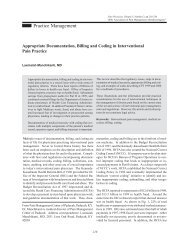ASIPP Practice Guidelines - Pain Physician
ASIPP Practice Guidelines - Pain Physician
ASIPP Practice Guidelines - Pain Physician
Create successful ePaper yourself
Turn your PDF publications into a flip-book with our unique Google optimized e-Paper software.
Manchikanti et al • <strong>ASIPP</strong> <strong>Practice</strong> <strong>Guidelines</strong><br />
38<br />
therapy. Before discography, the patients<br />
should have undergone investigation<br />
with other modalities which have<br />
failed to explain the source of pain; such<br />
modalities should include, but not be<br />
limited to, either computed tomography<br />
(CT) scanning, magnetic resonance imaging<br />
(MRI) scanning and/or myelography.<br />
In these circumstances, discography,<br />
especially when followed by CT<br />
scanning, may be the only study capable<br />
of providing a diagnosis or permitting a<br />
precise description of the internal<br />
anatomy of a disc and a detailed determination<br />
of the integrity of the disc substructures.<br />
Additionally, the anatomic<br />
observations may be complemented by<br />
the critical physiological induction of<br />
pain, which is recognized by the patient<br />
as similar to or identical with his/her<br />
complaint. By including multiple levels<br />
in the study, the patient acts as his/<br />
her own control for evaluation of the<br />
reliability of the pain response.<br />
Other indications for discography include: (1) ruling out<br />
secondary internal disc disruption or recurrent herniation<br />
in the postoperative patient; (2) exploring pseudoarthrosis;<br />
(3) determining the number of levels to include in a<br />
spine fusion; and (4) identifying the primary symptom-producing<br />
level when chemonucleolysis (enzymatic hydrolysis)<br />
or anular denervation (via thermocoagulation with an<br />
intradiscal catheter or a radiofrequency probe) is contemplated<br />
(173, 226).<br />
There are several potential sources of both false-positive<br />
and false-negative responses with provocative discography.<br />
Carragee et al (398, 399) concluded, that in individuals<br />
with normal psychometrics and without chronic pain,<br />
the rate of false-positives is very low if strict criteria are<br />
applied; and that the false-positive rate increases with abnormal<br />
psychometrics and increased annular disruption.<br />
Carragee et al (400) also showed that a high percentage of<br />
asymptomatic patients (40%) with normal psychometric<br />
testing who previously have undergone lumbar discectomy<br />
will have significant pain on injection of their discs that<br />
had previous surgery. Carragee et al (401) showed that<br />
even though a high-intensity zone is seen more commonly<br />
in symptomatic patients, the prevalence of a high-intensity<br />
zone in asymptomatic individuals with degenerative disc<br />
disease also was too high (25%) for meaningful clinical<br />
use. Carragee et al (402) also showed that discography<br />
does not cause long term back symptoms in previously<br />
asymptomatic subjects with normal psychometrics.<br />
Selective Epidural Injections<br />
As in the case with the intervertebral disc, spinal nerves<br />
can be injected with contrast, local anesthetic, or other<br />
substances (353). Both the provocative response and analgesic<br />
response provide clinically useful information.<br />
Steindler and Luck (318) recognized the validity of provocative<br />
and analgesic spinal injections as early as 1938.<br />
In 1971, McNab and coworkers (405) revealed the value<br />
of diagnostic, selective nerve root blocks in the preoperative<br />
evaluation of patients with negative imaging studies<br />
and clinical findings of root irritation. The nerve blocks<br />
were utilized to diagnose the source of radicular pain when<br />
imaging studies suggested possible compression of several<br />
nerve roots (406-418). The relief of usual symptoms<br />
following the injection of local anesthetic, 1 mL of 2%<br />
Xylocaine, was the main determinant for diagnostic information.<br />
Schutz and colleagues (407), Krempen and Smith<br />
(408), Tajima and colleagues (409), Haueisen and coworkers<br />
(410), Dooley and colleagues (411), and Stanley and<br />
coworkers (412) described positive results of diagnostic<br />
selective nerve root blocks. In 1992, Nachemson (419)<br />
analyzed the literature on low back pain and indicated that<br />
diagnostic, selective nerve root block provided important<br />
prognostic information about surgical outcome.<br />
Kikuchi and colleagues (415) estimated that approximately<br />
20% of the patients presenting with apparent radicular pain<br />
required diagnostic nerve root blocks or epidural blocks.<br />
Van Akkerveeken (420) recreated data from his 1989 thesis<br />
regarding sensitivity, specificity, and predicative values<br />
for diagnostic, selective nerve root blocks. A positive<br />
block required concurrent symptom reproduction during<br />
root stimulation and full relief following anesthetic infusion<br />
(416). Derby et al (413) correlated surgical outcome<br />
with pain relief following transforaminal epidural injections<br />
with local anesthetic and steroids and reported that<br />
patients who failed to obtain sustained relief of radicular<br />
pain following the block were less likely to benefit from<br />
subsequent surgical intervention.<br />
The controversial aspects of epidural injections include<br />
the terminology and technique (58). The terminology describing<br />
nerve root injections has varied from transforaminal<br />
epidural to selective nerve root block, selective nerve<br />
root sleeve injection, selective epidural, selective spinal<br />
nerve block, or selective ventral ramus block. However,<br />
<strong>Pain</strong> <strong>Physician</strong> Vol. 4, No. 1, 2001
















